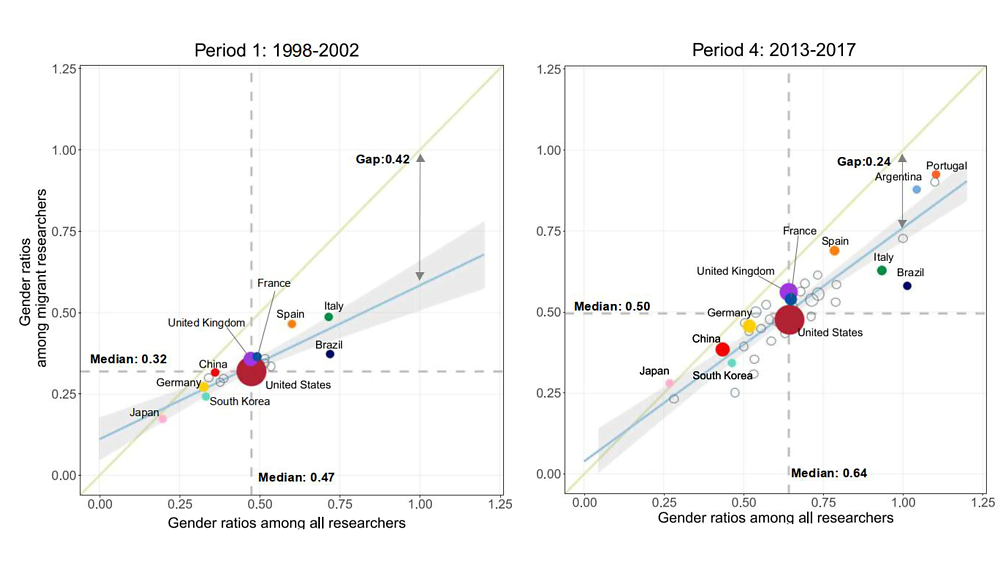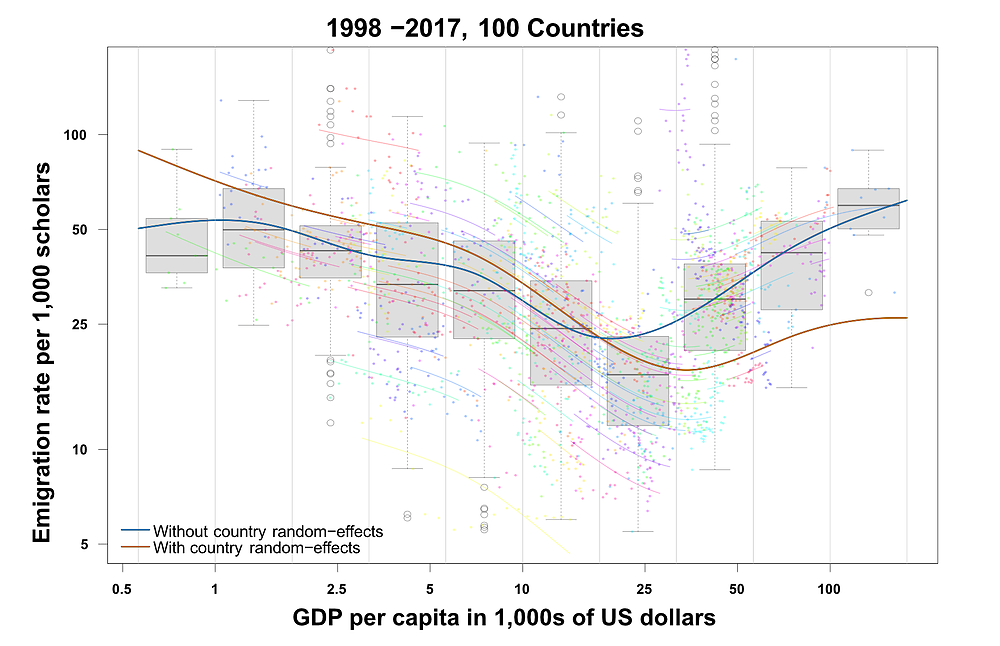Arbeitsbereich
Migration und Mobilität
Auf einen Blick
Projekte
Publikationen
Team
Projekt
Migration and Mobility of Scholars
Aliakbar Akbaritabar, Asli Ebru Sanlitürk, Xinyi Zhao, Tom Theile, Emilio Zagheni, Maciej Danko, László Németh; in Zusammenarbeit mit Samin Aref (University of Toronto, Kanada), Jevin West (University of Washington, Seattle, Vereinigte Staaten), Andrea Miranda-González (University of California, Berkeley, Vereinigte Staaten), Alexander Subbotin (Lomonosov Moscow State University, Russland), Francesco Billari (Bocconi University, Milan, Italien), Guy Stecklov (The University of British Columbia, Vancouver, Kanada)
Ausführliche Beschreibung
The migration of the highly skilled has important consequences for innovation and economic growth in sending and receiving countries. Understanding the processes that drive migration flows as well as the impacts of incentives and economic change is key to designing effective policies that address high-skilled migration and its consequences.
A key challenge when conducting research on highly skilled migrants is the lack of data. The recent availability of large-scale digital trace data from professional networking sites and large collections of scholarly publications has enabled researchers to study the population dynamics of professionals. In particular, bibliometric databases such as the Web of Science or Scopus offer the unique opportunity to follow career trajectories of scholars and their networks of coauthors over time and space. In this project, bibliometric data are used to contribute to the development of migration theories, such as on the relationship between economic development and migration and between internal and international migration. This project also offers a gender perspective on the global migration of scholars.
We used longitudinal data from Scopus over the 1998-2017 period to study the interrelation between the migration of scholars and economic development. The literature on migration and development has found empirical evidence at the population level that the emigration propensity on average initially increases with economic development up to a certain point and then decreases. We observed the opposite pattern for scholars: In low- and middle-income countries, their propensity to migrate internationally first decreases up to a certain point and then increases, following a U-shaped pattern. This implies that increasing economic development does not necessarily lead to an academic “brain drain” in low- and middle-income countries. Our further analyses on return migration will shed light on the role of economic development in the circulation of scientists.
International migration has been increasingly recognized as a strategy for scientists to advance their careers. While the migration research literature has suggested that the share of women among all international migrants has been increasing, we do not know whether male and female scholars participate equally in transnational mobility and how these patterns have shifted over time from a global perspective. Using bibliometric data that cover the past two decades, we have shown that while female researchers continued to be underrepresented among internationally mobile researchers and to migrate over shorter distances, this gender gap narrowed faster than the gender gap in the population of general active researchers.
As we develop our analyses, our ambition is to produce a dataset that maps the global migration of scholars at different levels of geographic and temporal granularity. This data will be used to assess the impact of policy changes on flows and on the network structure of migrants and to improve our theoretical understanding of the relationships between internal and international migration. We also develop methods to forecast future trends in the global scientific workforce and its mobility. Finally, we combine individual-level longitudinal data on scholars with aggregate-level rates; this will help us to improve our understanding of the micro-macro dynamics in migration and population change.
Geschlechterverhältnis zwischen allen Forscher*innen und migrierten Forscher*innen

Geschlechterverhältnis unter allen Forschern, die veröffentlicht haben (X-Achse) und Forschern mit Migrationshintergrund (Y-Achse). Die Größe des Kreises eines jeden Landes ist proportional zur Anzahl der Forscherinnen, die aus diesem Land zu- und eingewandert sind. Die grüne 45-Grad-Linie zeigt die Gleichheit zwischen den beiden Dimensionen, und die blaue Linie zeigt eine angepasste Regression. © MPIDR
Source: Based on the paper by Zhao, Xinyi; Akbaritabar, Aliakbar; Kashyap, Ridhi and Zagheni, Emilio, A gender perspective on the global migration of scholars, Proceedings of the National Academy of Sciences, https://doi.org/10.1073/pnas.2214664120, 2023
The relationship between emigration rates of scholars and economic development

Scholarly emigration rates (1998 to 2017) as a function of GDP per capita (2017 constant international dollars at purchasing power parity (12)). The combined data for each year and country are plotted as a box plot, while the country- and year-specific data are plotted using colored dots. Each color represents a separate country. With an increase in GDP per capita, the migration propensity of scholars first decreases. At higher income levels, it increases. © MPIDR
Source: Based on the paper by Sanliturk, E., Zagheni, E., Dańko, M. J., Theile, T., & Akbaritabar, A., Global patterns of migration of scholars with economic development. Proceedings of the National Academy of Sciences, 120(4), e2217937120. https://doi.org/10.1073/pnas.2217937120, 2023
Bildung und Wissenschaft, internationale Migration, ethnische Minderheiten, interne Migration, Wohnsituation, Urbanisierung, Migration, Statistik und Mathematik
Großbritannien, Mexico, Russland, Welt
Publikationen
Akbaritabar, A.; Dańko, M. J.; Zhao, X.; Zagheni, E.:
MPIDR Working Paper WP-2023-038. (2023)

Akbaritabar, A.; Theile, T.; Zagheni, E.:
MPIDR Working Paper WP-2023-018. (2023)

Şanlitürk, A. E.; Zagheni, E.; Dańko, M. J.; Theile, T.; Akbaritabar, A.:
Proceedings of the National Academy of Sciences of the United States of America 120:4, e2217937120–e2217937120. (2023)

Zhao, X.; Akbaritabar, A.; Kashyap, R.; Zagheni, E.:
Proceedings of the National Academy of Sciences of the United States of America 120:10, e2214664120–e2214664120. (2023)

Şanlitürk, A. E.; Aref, S.; Zagheni, E.; Billari, F. C.:
MPIDR Working Paper WP-2022-019. (2022)

Zhao, X.; Aref, S.; Zagheni, E.; Stecklov, G.:
Scientometrics 127:12, 7707–7729. (2022)

Zhao, X.; Aref, S.; Zagheni, E.; Stecklov, G.:
In: 18th International Conference on Scientometrics and Informetrics ISSI 2021: 12-15 July 2021, KU Leuven, Belgium; proceedings, 1369–1380. Leuven: ISSI. (2021)

Zhao, X.; Aref, S.; Zagheni, E.; Stecklov, G.:
Abstracts of the International Cartographic Association 3:327, 1–2. (2021)

Miranda-González, A.; Aref, S.; Theile, T.; Zagheni, E.:
EPJ Data Science 9. (2020)

Subbotin, A.; Aref, S.:
MPIDR Working Paper WP-2020-025. (2020)

Abel, G. L.; Muttarak, R.; Bordone, V.; Zagheni, E.:
European Journal of Population 35:3, 543–562. (2019)
Alburez-Gutierrez, D.; Aref, S.; Gil-Clavel, B. S.; Grow, A.; Negraia, D. V.; Zagheni, E.:
In: Smart statistics for smart applications : book of short papers SIS2019, 23–30. Pearson. (2019)

Aref, S.; Zagheni, E.; West, J.:
In: Social Informatics 11th International Conference, SocInfo 2019, Doha, Qatar, November 18–21, 2019, Proceedings, 50–65. Cham: Springer. (2019)